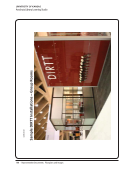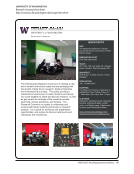SPEC Kit 327: Reconfiguring Service Delivery · 31
This change occurred with the construction of a Learning Commons.
This decision was primarily driven by user input. Users indicated a desire to be able to check out materials and interact
with reference staff in a single point of service. In addition, librarians are being asked to devote more time to proactively
interacting with faculty and students for their respective disciplines, and less time servicing students at the reference
desk.
Two factors led to this: We don’t get nearly as many print subscriptions as we used to, so the questions at the
periodicals service point had fallen off. Our Media Department is being split into the regular Media Desk (commercial
collection) and the Media Archives, which will be in a new special collections building, so the Media Desk needed a
home.
Two of the existing service points, Reference and Circulation, were located on different floors, making it difficult for the
two service areas to communicate and for patrons to receive seamless, consistent service.
We needed to relocate our video collection that no longer could fit into the small space in our reserves so it was a
combination of wanting to offer a new service and correct a space problem.
Example 1: Physical or Philosophical Change
5. If a physical change to a building or facility had a significant impact on the decision to reconfigure
this service, please briefly describe that change and the impact it had. If this did not have a
significant impact, please enter NA for Not Applicable. N=52
30 responded NA.
A new “Learning Studio” concept was implemented in Anschutz Library. This included new user space, group rooms,
and other improvements as well as collaborations with campus partnership (some of whom moved into the facility).
A new life science laboratory building was completed with general use space allocated for meetings and library support.
Kenan Science Library opened in Fall 2010. Originally designed as Kenan Chemistry Library, the facility replaced an
earlier Kenan Chemistry Library in a large and outdated chemistry complex that was demolished and rebuilt.
New building for School of Forestry and Environmental Studies had already greatly reduced the physical space and
collection size for the FES library. Within a year, it was determined to give over the library space to the school and
provide services on a consultation basis.
New business campus library collaborated with faculty on design of space and services.
Physical change was the decision (prior to the establishment of the Research Commons) to integrate Natural Sciences
Collections into the Main Collection. This freed up space for more innovative use. Shelving was removed, two service
points consolidated into one. Two other student support facilities nearby closed, one permanently (computer lab) and
one for a two-year remodel (student union). This increased need for technology-enabled spaces for students.
Plans for renovating the Zimmerman Reference Area into a Learning Commons was cited as a factor in the closing of the
reference desk. It was one of the first steps towards creating one-stop-shopping for UL patrons.
This change occurred with the construction of a Learning Commons.
This decision was primarily driven by user input. Users indicated a desire to be able to check out materials and interact
with reference staff in a single point of service. In addition, librarians are being asked to devote more time to proactively
interacting with faculty and students for their respective disciplines, and less time servicing students at the reference
desk.
Two factors led to this: We don’t get nearly as many print subscriptions as we used to, so the questions at the
periodicals service point had fallen off. Our Media Department is being split into the regular Media Desk (commercial
collection) and the Media Archives, which will be in a new special collections building, so the Media Desk needed a
home.
Two of the existing service points, Reference and Circulation, were located on different floors, making it difficult for the
two service areas to communicate and for patrons to receive seamless, consistent service.
We needed to relocate our video collection that no longer could fit into the small space in our reserves so it was a
combination of wanting to offer a new service and correct a space problem.
Example 1: Physical or Philosophical Change
5. If a physical change to a building or facility had a significant impact on the decision to reconfigure
this service, please briefly describe that change and the impact it had. If this did not have a
significant impact, please enter NA for Not Applicable. N=52
30 responded NA.
A new “Learning Studio” concept was implemented in Anschutz Library. This included new user space, group rooms,
and other improvements as well as collaborations with campus partnership (some of whom moved into the facility).
A new life science laboratory building was completed with general use space allocated for meetings and library support.
Kenan Science Library opened in Fall 2010. Originally designed as Kenan Chemistry Library, the facility replaced an
earlier Kenan Chemistry Library in a large and outdated chemistry complex that was demolished and rebuilt.
New building for School of Forestry and Environmental Studies had already greatly reduced the physical space and
collection size for the FES library. Within a year, it was determined to give over the library space to the school and
provide services on a consultation basis.
New business campus library collaborated with faculty on design of space and services.
Physical change was the decision (prior to the establishment of the Research Commons) to integrate Natural Sciences
Collections into the Main Collection. This freed up space for more innovative use. Shelving was removed, two service
points consolidated into one. Two other student support facilities nearby closed, one permanently (computer lab) and
one for a two-year remodel (student union). This increased need for technology-enabled spaces for students.
Plans for renovating the Zimmerman Reference Area into a Learning Commons was cited as a factor in the closing of the
reference desk. It was one of the first steps towards creating one-stop-shopping for UL patrons.






















































































































































































































